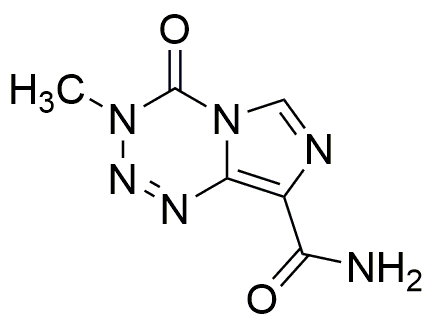Temozolomide is widely utilized in research focused on
- Cancer Treatment: Primarily used in the treatment of glioblastoma multiforme, a type of brain cancer, it works by damaging the DNA of cancer cells, which inhibits their ability to multiply.
- Combination Therapy: Often combined with radiotherapy to enhance treatment efficacy, allowing for a more comprehensive approach to managing aggressive tumors.
- Clinical Trials: Frequently a subject of clinical research aimed at improving treatment protocols for various cancers, providing insights into dosage and effectiveness.
- Pharmaceutical Development: Used in the development of new formulations and delivery methods, such as nanoparticles, to improve bioavailability and reduce side effects.
- Research on Resistance Mechanisms: Employed in studies investigating how certain tumors develop resistance to chemotherapy, helping to inform future treatment strategies.
General Information
Properties
Safety and Regulations
Applications
Temozolomide is widely utilized in research focused on
- Cancer Treatment: Primarily used in the treatment of glioblastoma multiforme, a type of brain cancer, it works by damaging the DNA of cancer cells, which inhibits their ability to multiply.
- Combination Therapy: Often combined with radiotherapy to enhance treatment efficacy, allowing for a more comprehensive approach to managing aggressive tumors.
- Clinical Trials: Frequently a subject of clinical research aimed at improving treatment protocols for various cancers, providing insights into dosage and effectiveness.
- Pharmaceutical Development: Used in the development of new formulations and delivery methods, such as nanoparticles, to improve bioavailability and reduce side effects.
- Research on Resistance Mechanisms: Employed in studies investigating how certain tumors develop resistance to chemotherapy, helping to inform future treatment strategies.
Documents
Safety Data Sheets (SDS)
The SDS provides comprehensive safety information on handling, storage, and disposal of the product.
Product Specification (PS)
The PS provides a comprehensive breakdown of the product’s properties, including chemical composition, physical state, purity, and storage requirements. It also details acceptable quality ranges and the product's intended applications.
Certificates of Analysis (COA)
Search for Certificates of Analysis (COA) by entering the products Lot Number. Lot and Batch Numbers can be found on a product’s label following the words ‘Lot’ or ‘Batch’.
Numéro de catalogue
Numéro de lot/série
Certificates Of Origin (COO)
This COO confirms the country where the product was manufactured, and also details the materials and components used in it and whether it is derived from natural, synthetic, or other specific sources. This certificate may be required for customs, trade, and regulatory compliance.
Numéro de catalogue
Numéro de lot/série
Safety Data Sheets (SDS)
The SDS provides comprehensive safety information on handling, storage, and disposal of the product.
DownloadProduct Specification (PS)
The PS provides a comprehensive breakdown of the product’s properties, including chemical composition, physical state, purity, and storage requirements. It also details acceptable quality ranges and the product's intended applications.
DownloadCertificates of Analysis (COA)
Search for Certificates of Analysis (COA) by entering the products Lot Number. Lot and Batch Numbers can be found on a product’s label following the words ‘Lot’ or ‘Batch’.
Numéro de catalogue
Numéro de lot/série
Certificates Of Origin (COO)
This COO confirms the country where the product was manufactured, and also details the materials and components used in it and whether it is derived from natural, synthetic, or other specific sources. This certificate may be required for customs, trade, and regulatory compliance.


